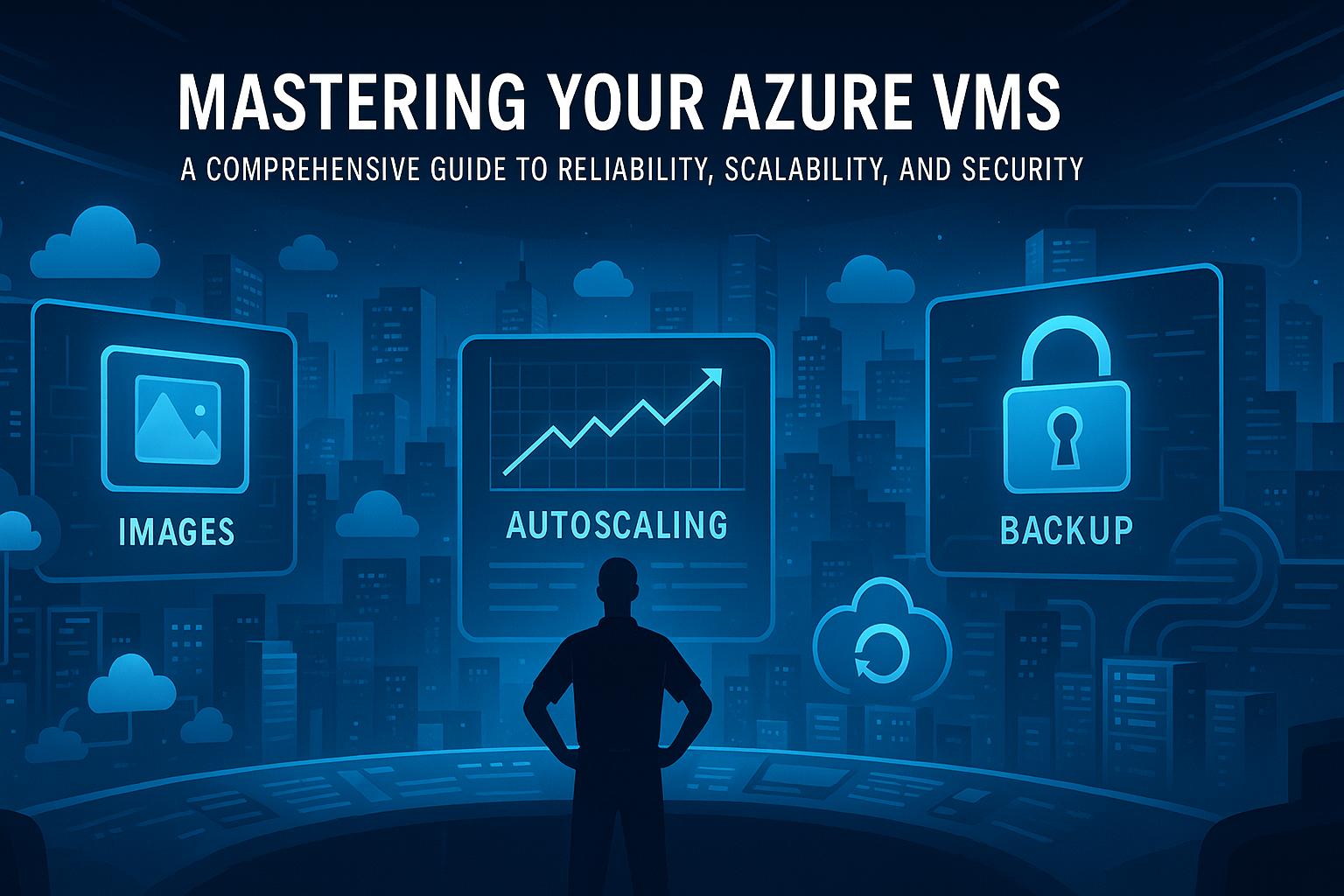Mastering Your Azure VMs: A Comprehensive Guide to Reliability, Scalability, and Security

In today’s cloud-first world, Virtual Machines (VMs) are the backbone of countless applications. While the basic concept of a VM as “a computer in the cloud” is well-understood, truly mastering Azure VMs goes beyond simple deployment. It involves leveraging powerful features for efficient management, seamless scaling, robust high availability, rapid disaster recovery, and ironclad security.
Let’s dive into the essential Azure VM services and concepts, using the analogy of building and managing a highly advanced, automated Restaurant Chain.
🍽️ The Foundation: Building Your Restaurants Efficiently
1. VM Images & the Compute Gallery
VM Image: A VM Image is a pre-configured operating system environment that includes software, settings, and configurations used to deploy consistent virtual machines.
Azure Compute Gallery: This service lets you manage, version, and replicate your custom VM images across multiple regions and subscriptions for easy, scalable deployment.
“When you open a new restaurant, you don’t start from scratch. You pull the same master plan: kitchen to cash register, menu to music system. VM Images do the same for cloud infrastructure, and the Compute Gallery is the archive keeping them safe and accessible.”
🔧 Keeping Your Restaurants Running Smoothly: Management & Efficiency
2. VM Configuration Management, Custom Script Extension & Azure Automation State Configuration
Custom Script Extension: An Azure VM extension that allows you to run scripts (PowerShell or Bash) after VM deployment. Ideal for post-deployment configuration or software installation.
Azure Automation State Configuration (DSC): A cloud-based implementation of Desired State Configuration that allows you to define and automatically enforce configuration standards on your VMs over time.
“The custom script is your launch-day checklist. DSC is your regional manager who visits regularly and ensures the daily SOPs are being followed. Without DSC, over time, each restaurant would slowly drift away from company standards.”
🚀 Handling the Rush: Scaling Your Restaurant Operations
3. VM Scale Sets (VMSS) & Autoscale
VM Scale Sets: A service that allows you to create and manage a group of identical, load-balanced VMs. Supports both uniform (identical VMs) and flexible (diverse VMs) models.
Autoscale: Automatically adjusts the number of running VMs based on performance metrics like CPU utilization or a custom schedule.
“When the lunch crowd hits, Autoscale opens new express lanes without you lifting a finger. Uniform VMSS builds identical counters, while Flexible lets you also pop up a fancy dessert bar.”
⚡ Weathering the Storm: Ensuring Your Restaurants Stay Open
4. High Availability & Proximity Placement Groups
Availability Sets: Logical groupings that ensure VMs are deployed across multiple fault and update domains within a single datacenter to reduce the risk of simultaneous downtime.
Availability Zones: Physically separate datacenter locations within a region, each with its own power, cooling, and networking, offering high availability against datacenter-level failures.
Proximity Placement Groups (PPGs): Enable you to co-locate your Azure resources in the same physical datacenter to reduce network latency between them.
“If your city block loses power, but your bakery uptown is open, you’re still in business. Availability Zones ensure you’re not putting all your eggs in one neighborhood.”
🔐 Protecting Your Business: Security, Disaster Recovery & Backup
5. Host Security & Disk Encryption
Host Security: Azure’s responsibility for securing the physical infrastructure, including datacenters, servers, and the hypervisor layer running your VMs.
Azure Disk Encryption (ADE): Protects data at rest on your VM’s OS and data disks using BitLocker for Windows or DM-Crypt for Linux. Keys are managed via Azure Key Vault.
“You can trust the mall (Azure) to be guarded 24/7, but your restaurant keeps sensitive data – like secret recipes and customer records – in safes (disk encryption).”
6. Azure Bastion
Azure Bastion: A fully managed PaaS service providing secure and seamless RDP/SSH connectivity to Azure VMs directly through the Azure portal, without exposing public IP addresses.
“It’s like teleporting your district manager from the HQ command center directly into the staff room of a store without ever touching the public entrance.”
7. VM Boot Diagnostics
Boot Diagnostics: Captures console output and screenshots during the VM startup process to help diagnose boot failures. Logs are stored in an Azure Storage Account.
“Instead of guessing, you watch the tape and see: ‘Ah, the fryer didn’t heat up!’ That’s your stuck VM boot process right there.”
8. VM Disaster Recovery (Azure Site Recovery)
Azure Site Recovery (ASR): A disaster recovery solution that replicates your VMs to another Azure region, enabling failover and failback to ensure business continuity in case of major outages.
“Think of it as having an identical twin store built in secret, ready to open its doors the moment your main one is out of action.”
9. Backup and Restore (Azure Backup)
Azure Backup: A service that allows you to back up entire VMs or specific data to a secure Recovery Services Vault. Supports point-in-time restores and long-term retention.
“One chef deleted the sauce recipe by mistake? No worries. Open yesterday’s book and recover it. Azure Backup keeps your history safe.”
🎯 Wrapping Up
Mastering Azure VMs isn’t just about spinning up cloud instances. It’s about building a resilient, scalable, and secure infrastructure that can adapt to real-world business demands.
By understanding and strategically using VM images, scale sets, automation, availability configurations, Bastion, backup, and disaster recovery, you can create a production-grade environment that performs reliably under pressure and recovers swiftly from failure.
Whether you’re a solo developer or an enterprise architect, these tools empower you to build infrastructure that works hard, scales fast, and stays safe.
Now that you have the blueprint, it’s time to build.